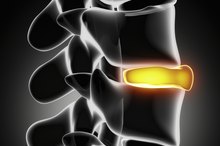The Effects of Bad Posture on the Skeletal System
Sitting up straight may seem like a simple instruction from your elementary school days, but good posture is serious health business. Posture refers to the alignment of your spine with all its adjoining structures. A person with good posture maintains proper alignment through all sitting, standing and lying positions. Bad posture in the form of slouching, hunching or slumping creates misalignment along the spinal column that disrupts nearly all major components of the musculoskeletal system. Failing to correct bad posture has significant implications for the skeletal system.
Misalignment
The skeletal ailments that result from bad posture are the result of misalignment in the spine. When you have good posture, the upper cervical curve, mid thoracic curve and lower lumbar curve of your spine balance along an imaginary vertical line that runs down your body from the top of your head to the bottom of your feet. Proper posture ensures that your spine is neither angled to either side of your body nor exaggerated along any of its natural curves. Improper posture disrupts the alignment of your spine by either over emphasizing one or more of the spinal curves, or by causing horizontal curvature to the spinal column. An improperly aligned spine disrupts alignment of other major bone and muscles, which can cause short-term pain or more long-term structural damage.
Joint Stress
Complications After an Ankle Sprain
Learn More
The joints in your body are protected by connective tissue designed to cushion and protect the joint during movement. The amount of connective tissue reflects the load bearing properties of the joint. A misaligned spine causes weight or stress to be redistributed throughout the body, so joints that were not intended to bear a significant amount of stress are now required to so do to compensate for poor posture. When joints bear stress beyond their capacity, the result is temporary or long-term pain as well as a degradation of the supportive connective tissue. Bad posture most commonly impacts joints in the spine, knees and shoulders.
Growth Issues
The skeletal system coordinates growth with muscle fibers in order to maintain alignment and balance. Some forms of chronic poor posture negatively impact normal growth patterns. For example, bad posture that places added stress on the vertebrae of the spine will cause the connective disks to wear down more quickly, compressing the bones of the spine and causing a loss in height. Bad posture that compresses bones and joints also inhibits muscle fiber growth, leading to reduced strength or stature.
Osteoarthritis
Causes of Chronic Ankle & Foot Pain
Learn More
Poor posture is one contributing factor to osteoarthritis. Osteoarthritis is the result of the severe degradation of the connective tissue between joints that protects the bones from rubbing together and causing pain. When posture disrupts the load bearing balance of your joints, connective tissue is wore down, exposing bone to bone. Occasionally, affected joints will calcify and fuse nearby bones in unnatural or painful positions, particularly in the spine and hands. Posture is particularly critical for osteoarthritis because the condition often exacerbates already poor posture, which can compound pain. Osteoarthritis cannot be cured or reversed, but the pain can be managed with physical therapy and medication.
Related Articles
References
Writer Bio
Hannah Wahlig began writing and editing professionally in 2001. Her experience includes copy for newspapers, journals and magazines, as well as book editing. She is also a certified lactation counselor. She holds a Bachelor of Arts in English from Mount Holyoke College, and Master's degrees in education and community psychology from the University of Massachusetts.








